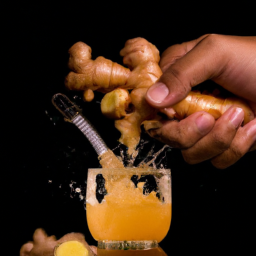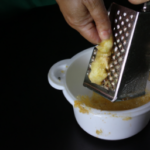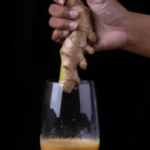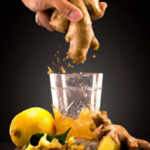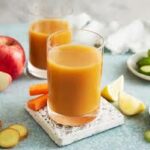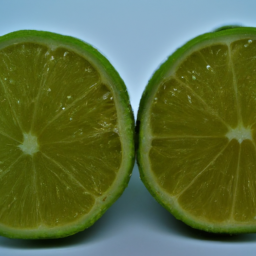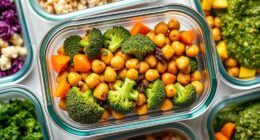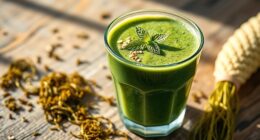I love adding ginger to my juices! It adds a zesty flavor and has numerous health benefits. Ginger is well-known for its ability to reduce inflammation, help with pain relief, and improve digestive health. Additionally, it is packed with antioxidants that can boost the immune system and protect against chronic illnesses.
If you’re interested in juicing ginger, there are a few things you need to know. In this article, I’ll walk you through the equipment you’ll need, how to choose the right ginger, the best cutting techniques, and the juicing process. I’ll also give you some ideas for mixing ginger with other fruits and vegetables and share some tips on storing your ginger juice.
So, let’s get started!
Key Takeaways
- Use a juicer or blender to make ginger juice
- Choose firm, plump, and heavy ginger with smooth skin and spicy aroma
- Wash and peel ginger before juicing, and mix with other fruits or vegetables for balance
- Store ginger in the refrigerator for up to three weeks or freeze for up to six months, and use ginger juice in juices, smoothies, cocktails, marinades, and dressings
Benefits of Adding Ginger to Your Juice
If you’re looking for a boost of flavor and health benefits in your juice, you’ve gotta try adding some ginger! Ginger is a root that’s been used for centuries in traditional medicine to treat a variety of ailments. It’s also a versatile ingredient in the culinary world, adding a unique flavor and aroma to dishes.
When it comes to health benefits, ginger is known to have anti-inflammatory and antioxidant properties. It can help reduce nausea, improve digestion, and boost the immune system. In addition, ginger has been found to have potential benefits for heart health, brain function, and even cancer prevention.
Adding ginger to your juice is an easy and delicious way to incorporate these health benefits into your diet.
To make ginger juice, you’ll need a juicer or a blender. The next section will explain in detail the equipment needed and the steps to follow for juicing ginger.
Equipment Needed
To get the most satisfying ginger juice, grab a sturdy juicer and a sharp knife. First, wash the ginger root thoroughly under running water and use the knife to cut off any rough spots or blemishes. You can peel the skin off the ginger, but it’s not necessary.
Cut the ginger into small pieces to make it easier to feed into the juicer. One of the juicing tips is to mix the ginger with other fruits or vegetables to balance out the flavor. Ginger can be quite spicy on its own, so adding a sweet fruit like apple or a citrus fruit like orange can help tone down the heat.
Another juicing tip is to use cold water to wash the juicer immediately after use to prevent any leftover ginger pulp from sticking to the machine. This will make cleaning up much easier.
Now that you know the equipment needed and ginger preparation, the next step is choosing the right ginger. Different types of ginger have different flavors, so it’s important to choose the right type to suit your taste preferences.
Choosing the Right Ginger
When choosing ginger, I always look for freshness, size, and shape, as well as whether it’s organic or conventional. Fresh ginger has a more potent flavor and aroma, so I prefer to buy it from a reputable source that has high turnover.
I also prefer ginger with smooth skin, a firm texture, and a uniform shape as these are signs of good quality. Additionally, I opt for organic ginger whenever possible to avoid exposure to pesticides and other chemicals.
Freshness
Fresh ginger is most flavorful within two weeks of being harvested, so it’s best to purchase it as close to its harvest date as possible. Did you know that ginger has been used for its medicinal properties for over 2,000 years? Using fresh ginger is crucial when juicing because it ensures that you get the maximum flavor and health benefits.
Here are some tips on how to preserve ginger’s freshness:
-
Refrigerate: Store fresh ginger in the refrigerator, wrapped in a paper towel and placed in a resealable plastic bag. This will keep it fresh for up to three weeks.
-
Freeze: If you have a surplus of ginger, freeze it in an airtight container or freezer bag. It will keep for up to six months.
Preserving the freshness of ginger is essential, but so is choosing the right size and shape for juicing.
Let’s take a look at the next subtopic and explore the best ways to prepare ginger for juicing.
Size and Shape
Properly selecting the size and shape of ginger is crucial for maximizing its flavor and health benefits when adding it to your juice blends. When juicing ginger, it’s best to choose roots that are firm, plump, and heavy for their size. The skin should be smooth and free of wrinkles, cracks, or blemishes. Additionally, the ginger should have a spicy aroma and a strong, pungent taste.
The size and shape of ginger can also affect the juicing process. Smaller pieces are easier to juice and can be added directly to the juicer. Larger pieces may need to be chopped or grated before being added to the juicer.
Regardless of the size, juicing ginger can offer numerous health benefits, such as reducing inflammation, improving digestion, and boosting immunity.
When it comes to choosing between organic and conventional ginger for juicing, it’s important to consider the potential exposure to pesticides. Organic ginger is grown without synthetic pesticides and fertilizers, reducing the risk of harmful chemical residues in your juice. However, if organic ginger isn’t available or affordable, conventional ginger can still be a healthy addition to your juice blends.
Organic vs. Conventional
Choosing between organic and conventional ginger can be a difficult decision, but it is worth noting that according to the Environmental Working Group, conventionally grown ginger ranks low in pesticide residue, with only 1.7% of samples showing detectable levels. However, if you are concerned about the use of pesticides and fertilizers in food production, organic ginger may be the way to go. Organic ginger is grown without the use of synthetic chemicals and has been found to contain higher levels of antioxidants and other beneficial compounds.
To help you make an informed decision, here is a table comparing the health benefits of organic and conventional ginger:
| Health Benefits | Organic Ginger | Conventional Ginger |
|---|---|---|
| Antioxidants | Higher levels due to natural growing methods | Lower levels due to pesticide use |
| Nutrient density | Higher levels due to natural growing methods | Similar to organic ginger |
| Pesticide residue | No synthetic pesticides used | Low levels of pesticide residue |
Ultimately, the choice between organic and conventional ginger depends on your personal values and priorities. If you prioritize reducing your exposure to synthetic pesticides, organic ginger may be the better choice for you. However, if you are looking for a more affordable option, conventionally grown ginger may be just as nutritious. Regardless of which type of ginger you choose, it is important to properly wash and peel it before juicing to ensure food safety.
Washing and Peeling
First, you’ll want to thoroughly wash and peel your ginger before juicing. This is important for juicing efficiency and for preserving nutrients. Ginger is often grown in sandy soil and can have dirt and residue on the skin, so it’s important to wash it well. Use a vegetable brush to scrub the skin, or simply rinse it under cold water and use your fingers to rub off any visible dirt.
Peeling the ginger is also important for a smoother juice. The skin can be tough and fibrous, which can affect the texture of the juice. Use a vegetable peeler or a sharp knife to remove the skin.
Once your ginger is washed and peeled, you can move on to cutting it into pieces for juicing. But how you cut the ginger can affect the flavor and texture of the juice. Let’s take a look at some cutting techniques that will help you get the most out of your ginger juice.
Cutting Techniques
To get the most flavor and texture out of your ginger, try using different cutting techniques that’ll make a difference in your juice. Knife skills are important when preparing ginger for juicing.
It’s recommended to slice the ginger into thin pieces or grate it to create a finer texture. This helps to release the flavor and essential oils from the ginger, making it easier to extract during the juicing process. Additionally, cutting the ginger into smaller pieces makes it easier to juice and extract more juice from it.
Flavor infusion is another important aspect of cutting ginger for juicing. By creating different shapes and sizes, you can infuse the ginger with different flavors that’ll enhance the taste of your juice. For example, cutting the ginger into small cubes or thin strips adds a spicy kick to your juice. Alternatively, grating the ginger creates a smoother texture that blends well with other fruits and vegetables.
By experimenting with different cutting techniques, you can create unique flavor combinations that’ll make your ginger juice stand out. Moving on to the juicing process, it’s important to use the right equipment to extract the maximum amount of juice.
Juicing Process
Once you’ve prepared your ginger, it’s important to use a juicer with a high yield. This is because ginger only yields about 25% juice by weight. To extract the juice, simply feed the ginger pieces into the juicer and collect the juice in a container.
It’s important to note that ginger juice can be quite potent, so it’s best to start with a small amount and adjust to taste. When it comes to the flavor profile, ginger juice has a spicy, slightly sweet taste with a hint of earthiness.
It’s a great addition to juices, smoothies, and cocktails, and can also be used in marinades and dressings. To incorporate ginger juice into your favorite recipes, try mixing it with other fruits and vegetables such as carrots, apples, and oranges. The possibilities are endless!
Mixing with Other Fruits and Vegetables
When incorporating ginger juice into your favorite drinks, it’s important to experiment with different fruits and vegetables to find the perfect balance of flavors for your taste buds. Ginger pairs well with citrus fruits like lemon and orange, adding a refreshing zing to your drink. It also complements sweeter fruits like apple and pear, providing a subtle warmth to the sweetness.
For those who prefer a more savory taste, mixing ginger juice with vegetables like carrot, beet, and celery can create a delicious and nutrient-packed drink. The key is to experiment with different juicing combinations until you find the right mix for your taste preferences. Don’t be afraid to try new things and switch up your ingredients to keep things interesting!
When it comes to storing ginger juice, it’s important to keep it refrigerated and consume it within a few days to ensure freshness. Properly sealing the juice in an airtight container can also help maintain its flavor and potency.
Now that you know how to mix ginger juice with other fruits and vegetables, let’s move on to the next section on storing your ginger juice.
Storing Ginger Juice
When it comes to storing ginger juice, there are a few things to keep in mind. First and foremost, it’s important to refrigerate the juice as soon as possible to preserve its freshness.
Alternatively, you can freeze the juice and thaw it as needed. It’s also important to note that ginger juice has a relatively short shelf life, so it’s best to consume it within a few days of juicing.
Refrigeration
To keep your ginger juice fresh, you’ll want to store it in the refrigerator after juicing. Refrigeration is necessary to extend the shelf life of ginger juice, as it slows down the growth of bacteria and fungi that can cause spoilage. Proper storage can help preserve the quality of the juice and ensure that it remains safe for consumption.
To store ginger juice in the refrigerator, it is important to transfer it into an airtight container. This will prevent air and moisture from getting in, which can cause the juice to deteriorate. Additionally, labeling the container with the date of juicing can help you keep track of the freshness of the juice. Below is a table summarizing the recommended shelf life of ginger juice in the refrigerator.
| Container | Shelf Life |
|---|---|
| Glass jar | 2 weeks |
| Plastic bottle | 1 week |
| Airtight container | 5-7 days |
Next, let’s explore how to freeze ginger juice for long-term storage.
Freezing
If you’re looking to preserve your spicy elixir for the long haul, the freezer is your best friend! Freezing ginger is a great way to keep it fresh for months, and it’s incredibly easy to do.
Simply wash and peel the ginger root, cut it into small pieces or grate it, and place it in an airtight container or freezer bag. Be sure to label it with the date so you know how long it’s been in the freezer.
Freezing ginger is an excellent long-term storage option, as it can stay fresh for up to six months in the freezer. When you’re ready to use it, simply remove the amount you need and return the rest to the freezer.
This method is especially useful for those who don’t use ginger regularly but want to have it on hand for when they need it. Now that we’ve covered freezing, let’s talk about shelf life and how to know when your ginger has gone bad.
Shelf Life
The longevity of your ginger root’s freshness is crucial to ensuring your dishes have the perfect kick of flavor. Ginger is a versatile ingredient that can be used in various cuisines, and preserving its freshness can be done in several ways.
One way to extend its shelf life is by storing it in a paper bag or airtight container in the refrigerator. This will help prevent moisture buildup, which can cause mold growth and spoilage.
Another preservation method is to freeze ginger. This is also a great way to have ginger on hand whenever you need it. Simply peel and chop the ginger into small pieces, place them in a freezer bag, and freeze. Frozen ginger can be grated or sliced easily and added to recipes without thawing. It’s important to note that while freezing may extend the shelf life of ginger, it may also affect its nutritional value.
Moving on to the next section about ‘recipes for ginger juice’, there are many ways to enjoy the health benefits and unique flavor of ginger in juice form.
Recipes for Ginger Juice
When it comes to making ginger juice, I love experimenting with different recipes and personalizing them to my taste. However, it’s important to keep in mind some safety precautions, such as washing the ginger thoroughly and using a clean juicer.
Despite these precautions, the benefits of ginger juice are undeniable. From its anti-inflammatory properties to its ability to aid digestion, ginger juice is a true superfood.
So let’s dive into some delicious recipes and enjoy all the goodness ginger juice has to offer!
Experimentation and Personalization
You’ll love juicing ginger once you discover how easy it is to personalize the flavor to your liking. Whether you prefer it slightly sweet or with a bit of kick, experimenting with different combinations of ingredients can help you achieve your desired flavor profile.
Here are some ideas to get you started:
- Mix ginger with apple or pear juice for a sweeter taste.
- Add lemon or lime juice for a tart, refreshing flavor.
- Blend ginger with carrots or beets for a nutrient-packed drink.
In addition to personal taste, it’s important to consider any potential health concerns when juicing ginger. Ginger is known for its anti-inflammatory properties and is often used to ease digestion and reduce nausea, but it can also interact with certain medications and cause side effects in some people.
As with any new dietary change, it’s best to consult with a healthcare professional before incorporating ginger juice into your routine.
When it comes to juicing ginger, safety precautions are also important to keep in mind. From properly washing and peeling the ginger to cleaning your juicer after use, there are several steps you can take to ensure a safe and enjoyable juicing experience.
Safety Precautions
To ensure a safe and enjoyable juicing experience with ginger, it’s important to take proper safety precautions. Ginger is a root that can be contaminated with harmful bacteria, so it’s important to handle it safely.
Before juicing ginger, make sure to thoroughly wash it under running water. Scrub the skin with a vegetable brush to remove any dirt or debris.
To further reduce the risk of contamination, consider using a separate cutting board and knife for ginger. This will prevent cross-contamination with other foods that may be present in your kitchen.
Additionally, always wash your hands thoroughly before and after handling ginger. By taking these simple safety precautions, you can enjoy the many benefits of ginger juice without worrying about harmful bacteria.
Now that we’ve covered the safety precautions, let’s move on to enjoying the benefits of ginger juice.
Enjoying the Benefits of Ginger Juice
Indulging in the health benefits of ginger juice can be a refreshing addition to your daily routine. Ginger juice is packed with antioxidants and anti-inflammatory compounds that can help improve digestion, relieve nausea, and reduce muscle pain. It’s also a great source of vitamin C and magnesium, both of which play key roles in maintaining a healthy immune system.
When it comes to dosage, it’s important to note that ginger juice can be quite potent. As a general rule of thumb, it’s recommended to start with small amounts and gradually increase as your body adjusts.
Ginger shots, which are concentrated doses of ginger juice, are a popular way to consume ginger. However, if you find the taste too strong, there are alternative methods such as adding ginger juice to smoothies or mixing it with honey and lemon for a soothing tea.
Whatever your preferred method, incorporating ginger juice into your daily routine can provide a wide range of health benefits.
Frequently Asked Questions
How do I know if the ginger I’m buying is fresh and high quality?
Selecting ginger is like picking a good apple. Look for firmness, smoothness, and a spicy aroma. Avoid any soft spots or wrinkles. These ginger quality indicators ensure a fresh and high-quality product.
Can I freeze ginger juice for later use?
Yes, ginger juice can be frozen for later use. Freezing preserves the nutrients and flavor. Ginger shots, made from ginger juice, have numerous health benefits including reducing inflammation and aiding digestion.
How much ginger should I add to my juice for maximum health benefits?
To maximize health benefits, I use juicing techniques that extract the most nutrients from ginger. Adding a thumb-sized piece to my juice provides anti-inflammatory and antioxidant properties, aiding digestion and immunity.
Are there any potential side effects of consuming too much ginger juice?
Consuming too much ginger juice can lead to digestive discomfort, heartburn and diarrhea. However, the benefits of ginger juice include anti-inflammatory properties, improved digestion and immunity. Check out ginger juice recipes for a healthy dose.
Can I use powdered ginger instead of fresh ginger for juicing?
As an avid juicer, I’ve found that using fresh ginger root gives the best results. However, if fresh ginger isn’t available, powdered ginger can be a suitable substitute. Just be sure to adjust the amount used accordingly. Juicing techniques can enhance the health benefits of ginger, such as reducing inflammation and aiding digestion.
Conclusion
In conclusion, adding ginger to your juice can provide numerous health benefits and a delicious flavor. By following the proper techniques for juicing ginger, you can easily incorporate this root into your daily routine.
Remember to choose fresh, firm ginger and wash and peel it thoroughly before cutting and juicing. As I sipped on my freshly made ginger and apple juice, I couldn’t help but think of the warm and spicy aroma of gingerbread cookies baking in the oven during the holiday season.
Juicing ginger not only adds a unique and enjoyable flavor to your juice, but it also provides a comforting feeling that can transport you to happy memories and moments. So why not try juicing ginger today and see how it can improve your overall health and well-being?
Ilana has been a vegan for over 10 years. She originally made the switch for health reasons, but soon found herself becoming more and more passionate about the ethical and environmental implications of a vegan lifestyle. Ilana is the author of The Graceful Kitchen, a blog all about veganism. She loves to cook up delicious and nutritious vegan meals, and share her recipes with others who are interested in leading a cruelty-free life. Ilana is also a strong advocate for using whole foods as the foundation of a healthy diet, and believes that going vegan is one of the best ways to achieve this.
